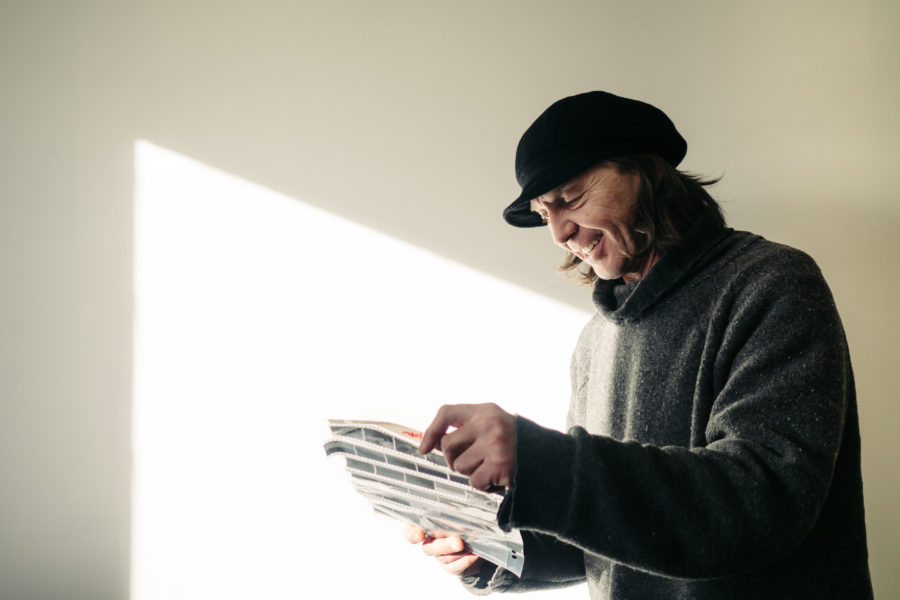A snapshot into the past: Local artist showcases passion for analog photography
Photographer Lysoha Svinarski looks at his negatives in his photography studio on Saturday.
February 14, 2016
In a coffee shop tucked in downtown Urbana, between the roar of the espresso machine and the chit and chatter of patrons, Lyosha Svinarksi sits, observing his surroundings with the eyes of an artist.
“She’s looking there, he’s looking at that, he’s looking down, she’s looking up, and then you combine this fan and the lights, and that’s where you start — that’s where magic comes from,” Svinarski said, pointing out the scenes around him with a gleam in his eye, mentally setting up theoretical photos in the café.
Svinarski’s passion for analog photography poured out as he explained traditional methods in film photography.
“Basically, it’s a combination of art and craft,” he said.
In the days of digital technology, analog photography has become less common. However, for Svinarski, analog has, and will always, be the only way.
Get The Daily Illini in your inbox!
A passion is born
Svinarski began his passion in what used to be the Soviet Union. Photography was always significant in his family. Svinarski’s first exposure to analog was when his grandfather introduced him to an old Leica camera from the World War II era.
“For me, it was a toy. … (Later on), my grandfather took his camera away from me. He was afraid I was going to break it, so he gave me another one,” he said.
Svinarski took this camera wherever he went and took pictures of anything and everything he saw, using surroundings in Leningrad to inspire him. The hobby was fun for him, and he even processed and printed his film in a bathroom with the aid of small-sized equipment like an enlarger, a transparency projector used to print photographs from film or negatives.
But his hobby didn’t become his obsession until he moved to the United States with his family, to the town of Urbana, in 1989.
While living in Leningrad, Svinarski was in medical school and dreamed of becoming a pediatrician. He planned on pursuing these passions when he came to Urbana.
“I really like kids, I really like to be with them, and I think mentally, I’m on the same level (as them),” he said with a chuckle.
Though this was his initial plan, upon moving, Svinarski began working at a local film lab in Champaign and began to take photography more seriously. Working as a technician allowed him to ask questions and learn from his colleagues. During this time, he learned the more technical side of analog. After studying the styles of different photographers and experimenting on his own, Svinarski combined self-taught experiences and his own background in painting to help him take the leap and focus on being an artist first and foremost.
“It’s like jumping off a cliff. You gotta jump, there’s no plan B,” he said, comparing becoming a full-time artist to a free-fall into the unknown.
A passion is shared
After years of freelancing and working on his craft, Svinarski began the Urbana Museum of Photography in 2012. It started off as a nonprofit museum that displayed antique cameras and examples of photography from the past. A couple years in, however, Svinarski realized his passions were not being put to good enough use.
“After two years of basically running everything by myself, we moved to our current location, and I started concentrating on photo classes and teaching,” he said.
Teaching the three steps of analog (shooting, processing and printing) has more heart and soul than in its digital counterpart nowadays, according to Svinarski. He said analog requires more creativity and thought.
“(Digital photography) is losing its attachment to reality. It’s becoming more cold, more isolated,” he said.
Svinarski isn’t the only one who thinks this. Some of his students in the past few years have commented on why they wanted to learn the traditional way of taking photos, though the technique itself has become less popular.
Ziang Xiao, senior in Engineering, started taking Svinarski’s class last semester because he wanted to explore a method that was more unique, in his opinion, than digital photography. He said that Svinarski’s charisma makes the learning process more fun.
“He is very passionate about what we are doing. The teaching is an interactive process, and his belief is not only to teach us this and that — it’s more like we’re learning together,” Xiao said.
This is one of the reasons that students keep coming back — and another reason why students are inspired to pursue analog on their own.
Zheyuan Gu, junior in Engineering, and president of the Vintage Analog Manual Photography club on campus, said Svinarski is always close to the club because of his passion and practical examples of thinking outside of the box.
“In his pictures, there are mundane things, but he can turn (them) into something that’s fascinating,” Gu said.
For amateur photographers at any stage, Gu thinks this ability is invaluable and is grateful that Svinarski remains closely linked to the club.
A passion continues
Though Urbana High School, Parkland College and the University have a dark room, they are only available to students. Because Svinarski’s classes are open to everyone in the public, he prides himself for having the only public darkroom in the C-U area. As the museum is open for classes again this spring, Svinarski welcomes all students, regardless of age and level of familiarity with analog photography. He said he also welcomes other types of photographers (even digital ones) to provide different perspectives of other facets of photography.
Ultimately, Svinarski believes that analog photography is an endless process, and he works to keep his passion alive one class at a time.
“You keep learning, you keep challenging yourself with vision and techniques. There are so many things to discover. You can find who you are here.”







